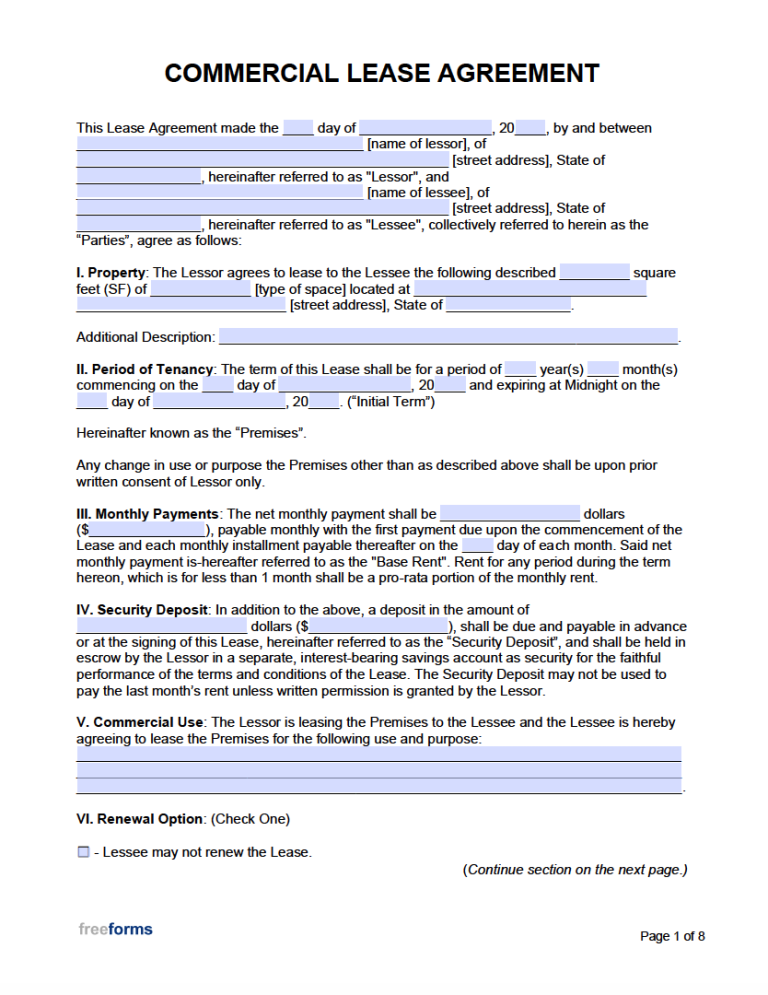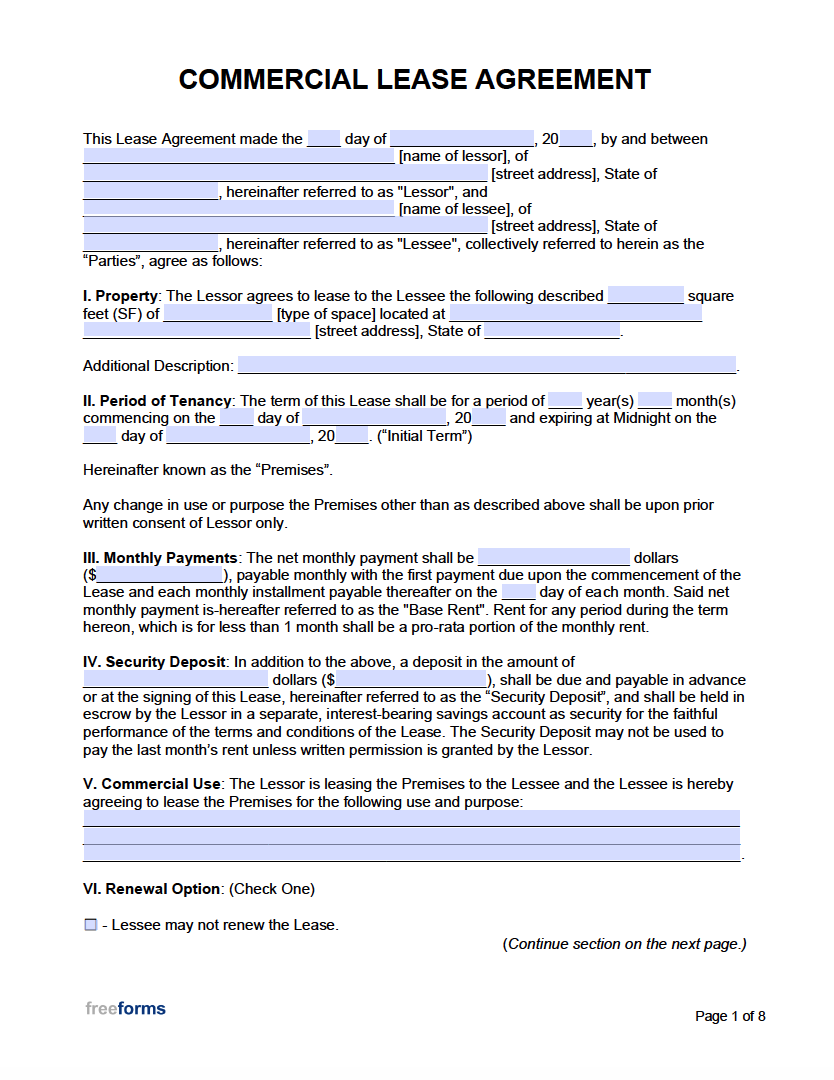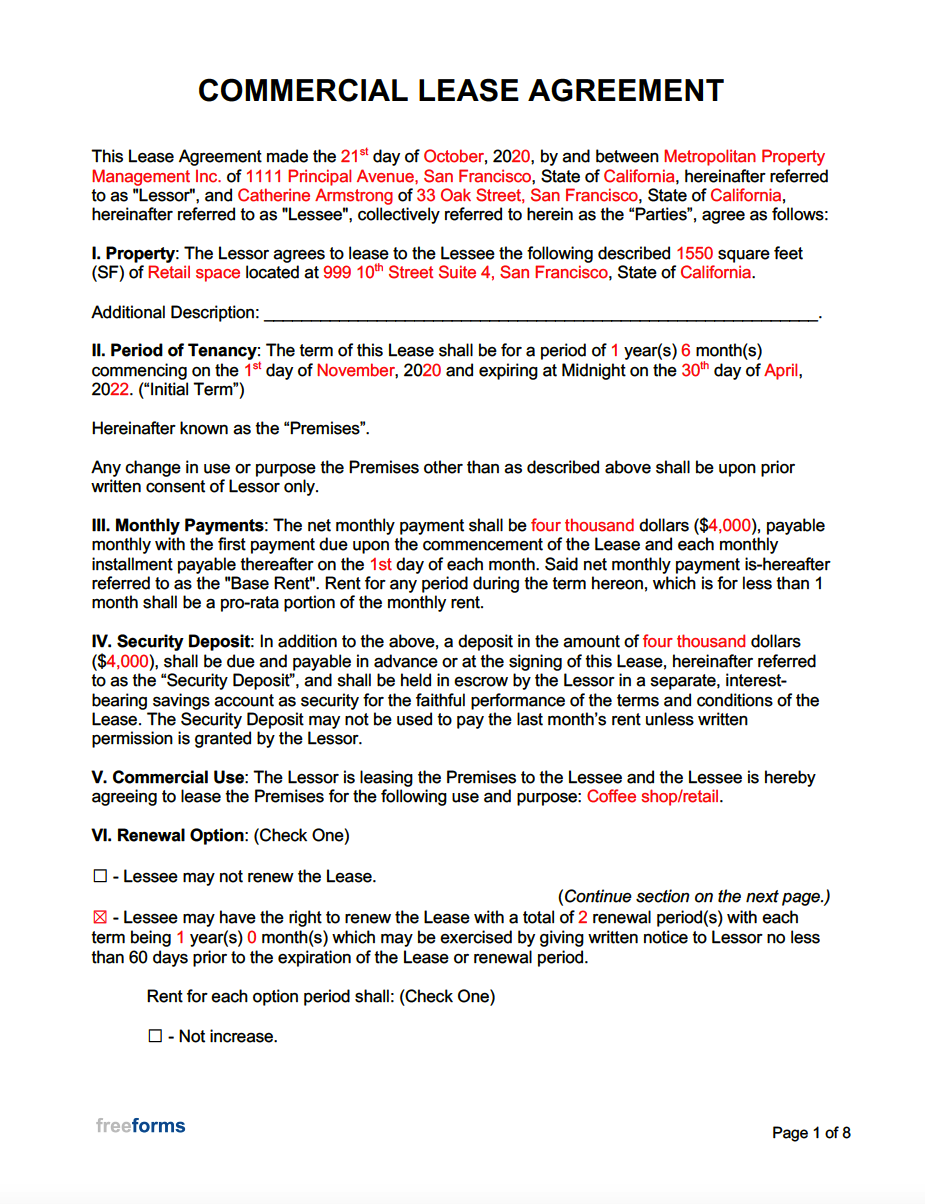Commercial Rental Application – When considering a prospective tenant, the landlord of a commercial property should seek the security of a low-risk candidate for the occupancy. One way to gather data on a possible lessee is to evaluate via a rental application. This instrument can obtain specifics about them that are related to their previous rental locations, income generated, and credit history for the purpose of demonstrating their worthiness to rent.
By State
- Alabama
- Alaska
- Arizona
- Arkansas
- California
- Colorado
- Connecticut
- Delaware
- Florida
- Georgia
- Hawaii
- Idaho
- Illinois
- Indiana
- Iowa
- Kansas
- Kentucky
- Louisiana
- Maine
- Maryland
- Massachusetts
- Michigan
- Minnesota
- Mississippi
- Missouri
- Montana
- Nebraska
- Nevada
- New Hampshire
- New Jersey
- New Mexico
- New York
- North Carolina
- North Dakota
- Ohio
- Oklahoma
- Oregon
- Pennsylvania
- Rhode Island
- South Carolina
- South Dakota
- Tennessee
- Texas
- Utah
- Vermont
- Virginia
- Washington
- West Virginia
- Wisconsin
- Wyoming
By Type
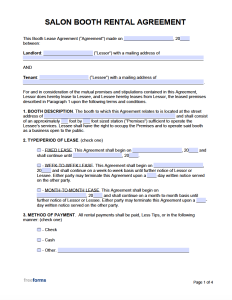 Booth (Salon) Rental Agreement – A form used to document the renting of a small space within a larger commercial property, specifically used for those carrying out services related to the massage and cosmetology fields.
Booth (Salon) Rental Agreement – A form used to document the renting of a small space within a larger commercial property, specifically used for those carrying out services related to the massage and cosmetology fields.
Download: Adobe PDF, MS Word (.docx)
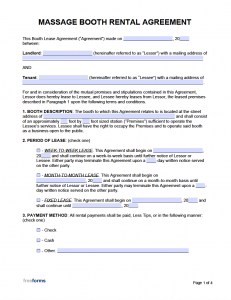 Booth (Massage) Rental Agreement – Allows the lessor, usually the proprietor of a business that offers massage services, to lease a portion of a larger property to the lessee who will be using the area to conduct therapeutic services for a fee.
Booth (Massage) Rental Agreement – Allows the lessor, usually the proprietor of a business that offers massage services, to lease a portion of a larger property to the lessee who will be using the area to conduct therapeutic services for a fee.
Download: Adobe PDF, MS Word (.docx)
 Garage (Parking) Rental Agreement – A consolidated outline of the rights and expectations associated with the rental of a parking space to store a vehicle.
Garage (Parking) Rental Agreement – A consolidated outline of the rights and expectations associated with the rental of a parking space to store a vehicle.
Download: Adobe PDF, MS Word (.docx)
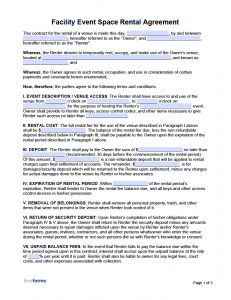 Facility Event Space Rental Agreement – Assigned paperwork that transcribes the pertinent information of an accord to rent out space to be used for an event or party.
Facility Event Space Rental Agreement – Assigned paperwork that transcribes the pertinent information of an accord to rent out space to be used for an event or party.
Download: Adobe PDF, MS Word (.docx)
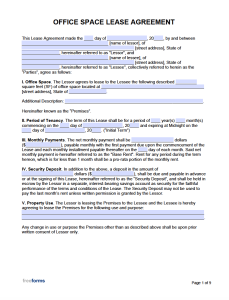 Office Space Lease Agreement – A valid contract to record the corroborating details concerning a rental property (or segment of a rental property) for a company’s office needs.
Office Space Lease Agreement – A valid contract to record the corroborating details concerning a rental property (or segment of a rental property) for a company’s office needs.
Download: Adobe PDF, MS Word (.docx)
 Triple-Net (NNN) Lease Agreement – A type of commercial lease where the tenant is responsible for paying the rent as well as all the property’s additional expenses, e.g. taxes, building maintenance, and insurance.
Triple-Net (NNN) Lease Agreement – A type of commercial lease where the tenant is responsible for paying the rent as well as all the property’s additional expenses, e.g. taxes, building maintenance, and insurance.
Download: Adobe PDF, MS Word (.docx)
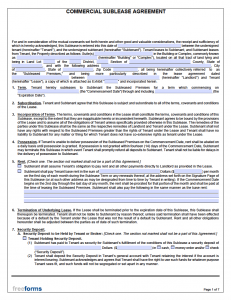 Commercial Sublease Agreement – A register presented as a source to transcribe the particulars of a lease where a tenant wishes to transfer their rights to occupy the premises to a subtenant.
Commercial Sublease Agreement – A register presented as a source to transcribe the particulars of a lease where a tenant wishes to transfer their rights to occupy the premises to a subtenant.
Download: Adobe PDF
What is Commercial Property?
Unlike residential property where the main goal is to live on the premises, commercial property’s main function is to accommodate a business’s operational needs. But, not all real estate can be converted to commercial property, it must be located within a certain area that is zoned accordingly. Also, there are different kinds of zoning for the different types of commercial properties. The main types being:
- Retail – Property utilized by companies to sell their products/goods, e.g. various types of stores, malls, shopping centers, etc.
- Office – Commercial space where a business can locate a workplace for its employees to carry out certain office activities (typically for administrative purposes).
- Industrial – Larger properties generally used to contain a warehouse or factory operation, i.e. for manufacturing purposes.
(Retail and office properties are commonly zoned under the same category, whereas industrial space is zoned under a separate classification.)
What is a Commercial Lease?
Before getting involved in the rental of commercial space, whether you are a landlord or tenant, it is imperative that you have a basic understanding of the corresponding lease agreement. The first thing that you should be aware of is the different types of lease structures in terms of how the expenses are handled. These being:
- Gross – A type of lease where the tenant is only responsible to pay the cost of the rent. This price is typically based on the square footage of the property and the landlord is accountable to pay for all of the additional expenses, such as the cost of utilities, insurance premiums, repairs & maintenance, and under certain circumstances, taxes. (Landlords may want to take these additional expenses into account when calculating the price per square foot.)
- Modified Gross – Unlike the abovementioned type of lease where the tenant is only obligated to make one all-inclusive payment each billing cycle, contracts utilizing the modified gross feature enable users to divide certain costs as desired. However, the tenant will still be responsible to pay a base rent in addition to the assigned expenses, e.g. the tenant is responsible for the base rent and utilities.
- Triple Net (NNN) – This formatting requires the tenant to pay all the expenses associated with the property along with the cost of the rent.
How to Lease Commerical Space
The process of leasing commercial real estate is more intricate than renting out a residence. That is why most people in the industry recommend that any owners of commercial space should hire the services of a real estate agent who specializes in this field (their commission fees will usually run from 3-6% of the total lease payments during the initial term). With that being said, it is not an impossible endeavor to try to lease the premises yourself. If this interests you, refer to the steps below to help guide you through the process of leasing your own commercial property.
Step 1 – Determine What the Rent Will Be

What is the value of your property? To answer this question, you are going to want to:
- Look at Comparables – Research similar commercial properties that are currently on the market. How much are they charging per square foot? Gathering this type of data could really help you get an idea of how much you should be charging for the base rent.
- Calculate the Price Per Square Foot – Once you have a figure in mind, it is important that you know the size of your property’s “usable space”. This can be achieved by measuring the length and width of each area and multiplying the numbers together to get the square footage. Once you have added all the areas together to obtain the total number, you can now multiply the number of square feet by the rate you settled upon to get a general idea of how much you can charge the tenant. (Properties that have shared common areas with other tenants, known as “rentable space”, will have to use the proper calculations to account for this additional square footage.)
Step 2 – Advertising the Property
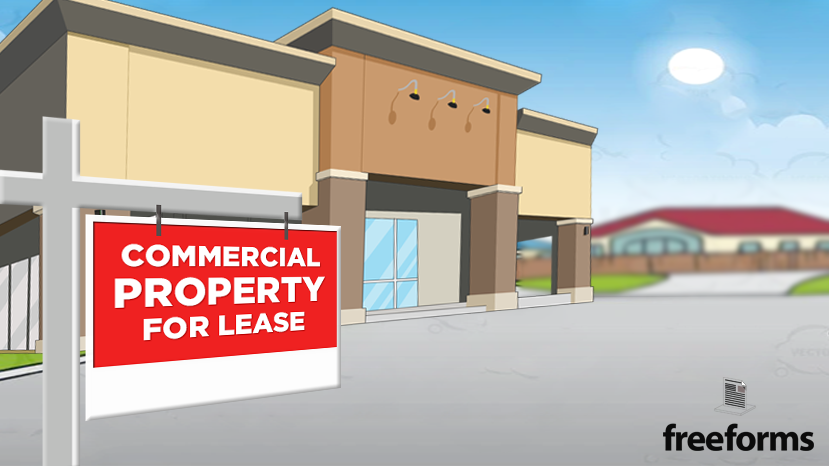
Now that you have a price in mind, it is time that you properly market the property in order to find a tenant to occupy the space. You may want to consider:
- Posting a Sign – As some of the old ways of advertising have become less effective, placing a “For Lease” sign on the property is still an efficient way to notify the community that you have available space for rent, especially if the property is located in a high traffic area. It also helps interested parties find the location easier when meeting to view the premises.
- Creating an Online Ad – As you may know, the internet has become one of the primary tools when it comes to getting the word out about an available property. Adding posts to the various websites that specialize in the leasing of commercial real estate is a huge benefit to you and your objective. Here, you will be able to present online browsers with images of your property, a description of what the space has to offer, and the specifics of your current proposal. The premier websites for this include:
- LoopNet.com
- CoStar.com
- 42Floors.com
- OfficeSpace.com
- CraigsList.org (Select Location>Housing>Office/Commercial)
Step 3 – Showing the Available Space
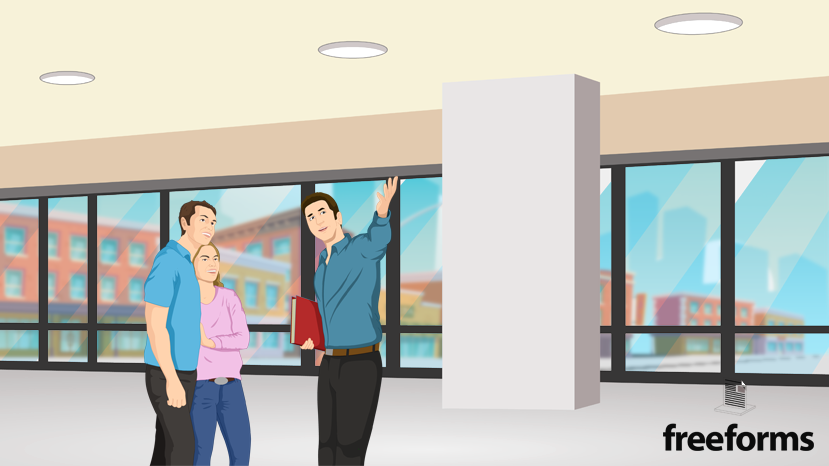
Hopefully, if your property is appropriately priced, you will be contacted by individuals interested in your property. Be sure to promptly answer any phone calls and emails concerning your ad. It is only a matter of time before you will receive a request to view the space in person. In order to entice visitors to lease your property, you may want to:
- Arrange the Property – First impressions can really affect somebody’s perception of the space. That is why owners/landlords should ensure that the premises clean, organized, and up-to-date in regard to the property’s maintenance & repairs. Making certain improvements might be worthwhile if it can get you a higher rent.
- Prepare any Necessary Documentation – When showing the space, you are going to want to make sure you can answer any questions that the prospective tenants might ask, that is why it is important to have any documents related to the property accessible to use as a reference. It is also a good idea to have a copy of the commercial lease agreement on hand in case the other party wants to secure the rental right then and there.
Step 4 – Negotiating the Terms

Prior to carrying out the lease agreement, the prospective tenant will usually want to discuss the terms & conditions of the occupancy. The major components of which would include:
- Term – Length of time the tenant may rightfully occupy the space.
- Base Rent – The fixed amount charged monthly.
- Expenses – Is the contract going to use the gross, modified gross, or triple net (NNN) structure?
- Security Deposit – The amount paid by the lessee and held by the lessor to cover the cost of any damages or unpaid bills should they occur during the course of the tenancy.
- Renewal Option – Will the tenant have the right to renew the terms upon the expiration of the lease?
- Use of Property – What purpose will the space be used for and does it coincide with the zoning of the property’s district?
- Leasehold Improvements – Alterations made to the property by the tenant in order to better fit the needs of their operation.
(Apart from these main factors of the rental contract are additional provisions that both parties should also read and acknowledge.)
Step 5 – Signing the Contract

If the parties were able to come to a meeting of the minds in relation to the aforementioned terms, it will be time to commence the execution of the commercial lease agreement. Once the details have been transferred to the contract, the participating individuals should offer the following in the presence of a notary public:
- Date of the Document’s Execution
- Lessee’s Signature
- Lessor’s Signature
Upon the above actions being completed, the agent possessing notarial powers shall complete the two (2) designated sections (one (1) for the lessor and one (1) for the lessee).
Recommended Clauses
Americans with Disabilities Act – ADA (42 U.S. Code § 12183) – Any business that serves the public or has fifteen (15) or more employees must equip their property with an entryway that is accessible to those with disabilities. This act should be included within the content of the lease agreement for the purpose of clarifying that the landlord and tenant both acknowledge this law that was put forth by the federal government.
Hazardous Waste (42 U.S. Code § 6901) – Individuals participating in a lease for commercial property may cite this law concerning the proper disposal of harmful waste materials as it pertains to the tenant’s trade. Landlords may also include a provision that states that the tenant is prohibited from having hazardous materials on the premises without their consent (sample clause).
Frequently Asked Questions (FAQ)
Differences Between Usable and Rentable Square Feet?
When determining a commercial property’s annual or monthly rent, the square footage of the available space plays a major role in calculating the sum of the payments. But, there are some factors that have to be taken into account in order to get an accurate number. You must understand the difference between the following types of space:
- Usable Square Footage – The number of square feet designated for the tenant’s use only. In other words, the tenant and their business have exclusive rights to this portion of the building and no neighboring tenants may encroach upon this area.
- Rentable Square Footage – Areas of a larger structure that are shared by adjoining tenants, e.g. lobbies, communal restrooms, stairways, etc.
How to Calculate Price Per Square Foot?
Before you can calculate a property’s rent using the square footage, it is essential that you first establish the market rate for properties alike. Once you have a number in mind, you may review the terms and formulas below to better understand the process of computing the lease payments:
- Load Factor – For individuals who own property within a larger structure that has common areas, this formula should be carried out to establish the percentage of rentable space in relation to the entire building’s usable space. So, the formula to obtain the load factor percentage would be:
Entire Building’s Rentable Square Footage ÷ Entire Building’s Usable Square Footage = Load Factor Percentage
- Rentable Space – In order to find out the rentable square footage of the landlord’s portion of the property, you would perform the following calculation:
Landlord’s Useable Square Footage × Load Factor Percentage = Landlord’s Rentable Square Footage
- Total Available Space – Now that the landlord knows the square footage of their property’s usable and rentable space, they can then add the two (2) numbers together like so:
Landlord’s Useable Square Footage + Landlord’s Rentable Square Footage = Landlord’s Total Square Footage
- Annual Rent – If the owner has a figure in mind for the price per square foot, they can then apply this formula for the yearly cost of rent:
Landlord’s Total Square Footage × Price Per Square Foot = Annual Rent
- Monthly Rent – To further narrow down the cost of rent to a monthly figure, you may carry out the final equation like so:
Annual Rent ÷ Twelve Months = Monthly Rent
How to Negotiate a Commercial Lease?
Business owners looking to rent space to provide their customers with the services and products they have to offer will need to educate themselves on the current commercial real estate climate. But, they will first need to determine what kind of property they require to function in an efficient manner. Narrow down the options by identifying the following aspects of your business model:
- Type of Business – Is the business categorized under retail, office, or industrial?
- Location – Where would you like to establish your business? (An area with a higher traffic count can bring in more customers.)
- Square Footage – What is the minimum square footage required to carry out your operation?
- Layout – What type of floor plan would best suit my needs?
- Budget – How much can I afford to spend each month on rent/expenses and still make a profit?
Now that you have an idea of what kind of space your business requires, you may research local properties that fit this description. Exploring what the market has to offer will also help you get a feel for what the going rate is per square foot. Once you feel you have a good understanding of the current marketplace, it will be time to view the properties of interest. Upon meeting with these owners (or their representatives), consider broaching the following subjects regarding the lease:
- Base Rent – Most landlords set a certain price knowing that individuals are going to request a discount on the payments. This is why it is imperative that you ask for a reduction on the amount of based rent (you should seek a minimum reduction of 10%).
- Type of Lease – Come to an agreement with the landlord on how the expenses will be handled, i.e. gross, modified gross, or triple net format. (This may depend on the type of business operation that will be carried out on the premises.)
- Fees – Many landlords will try to insert as many fees as possible into the contract. Comb through the initial offer and make sure that there are no unreasonable charges associated with the tenancy. If there are, you may request that they are removed in order to proceed with the transaction.
- Fixturation Period – If the property requires certain improvements in order to accommodate the tenant’s needs, then the tenant may request that the landlord offer a certain period of days/months where the occupant is exempt from lease payments.
- Inducements – When a property has been on the market for a long period of time, the tenant will usually have the upper hand in negotiating the terms of the contract. If this is the case, tenants are urged to request certain concessions out of the landlord. A common inducement would be one (1) to two (2) months of “free rent”.
- Term – The longer the term, the more leverage the tenant will have in negotiating price reductions. Landlords prefer the security of knowing that their property is going to be occupied for a substantial period of time and they may be willing to knock off a couple of months of rent in order to seal the deal.
- Option to Renew – A key factor of the commercial lease, an option to renew gives the tenant the right to re-up the contract upon the time of the lease’s expiration. Lessees should make sure to secure a renewal option that they are comfortable with, otherwise, they may have to reluctantly move to another location after the end of the initial term.
In addition to these factors of the lease are some clauses that tenants should try to either include or avoid. Read the sections below to better understand each contractual provision:
- Competitor Clause – A clause that prohibits the landlord from renting space (within the same building) to a competing business in the same industry as the tenant.
- Co-Tenancy Clause – If you rely on the traffic brought in by a larger neighboring company and they happen to relocate, this provision can provide tenants with the right to break the lease upon this occurrence. (Mainly used for properties located within a strip mall.)
- Cure Clause – Implemented for the benefit of the lessee, this paragraph provides the tenant with a certain period of days to remedy a violation of the lease before being charged with a penalty.
- Sublease Clause – Permits the lessee to re-rent the property to another party. It may be wise for the tenant to try to incorporate this into the contract as a backup plan in case they need to vacate the premises.
- Early Termination Clause – There will usually always be repercussions when breaking a lease. But, if you can negotiate these penalties before starting the occupancy, you may be able to reduce potential future damages if you ever need to end the lease early.
- Relocation Clause – This is a clause that favors the landlord and allows them to relocate the tenant to another portion of the building at will. It is highly recommended that lessees not allow this to be included within the content of the lease agreement.
Keep in mind, negotiating the rental of multiple properties gives you the advantage when speaking with the owners of commercial real estate. The more options you have, the more you will be able to walk away if the owner doesn’t meet your demands. It should also be noted that it will be significantly easier negotiating with an independent landlord as opposed to a corporation. (You may also want to consider hiring the services of a qualified real estate agent or attorney to advise you on the many facets of commercial real estate.)
How to Get Out of / Break a Commercial Lease?
When owning and operating a business, there is always a chance of things going awry. Individuals never intend on having to break a lease, but it is something that may have to occur if they can no longer afford the tenancy. It can also happen if the tenant’s business is a success and they need to upgrade to a larger facility. If you are contemplating backing out of your lease obligations, you may want to first consider some of the following measures that can be taken to lessen the blow of ending the contract early (this section can also help those about to enter into a contract, as it provides information on how to implement certain things that could protect you in the future):
- Negotiating a Reasonable Early Termination Policy – When formulating an agreement to lease the premises, lessees may insist on including a provision that states what the penalties will be should they end the occupancy early. This way, they are not taken by surprise and know exactly what to expect if they need to back out of the contract.
- Subletting the Property – If permissible, the tenant can sublease the premises to another party in order to maintain the necessary payments that must be paid each billing period. (To be able to do this, the lessee should try to incorporate a clause authorizing this action during the inception of the lease agreement.)
- Assigning the Lease – Not to be confused with subleasing, this procedure involves the current tenant assigning the original lease to a third party, as opposed to a sublet where a new contract is written up and the primary tenant is still legally attached to the property. In other words, a new tenant takes over all the conditions of the initial lease, and the vacating party has no liability whatsoever once the transfer is executed. (The owner/landlord will have to sign off on this action in order for it to occur.)
- Licensing the Space – If the lessee is in financial trouble but wants to ride out the rest of a tenancy to avoid the consequences of breaking the lease, then they can consider licensing a portion of the property to another individual/entity to reduce their expenses. This does not give the party receiving the license any exclusive rights to occupy the premises, but rather a shared use that is mutually coordinated.
- Speak with the Landlord – If none of the previously mentioned options are possible, it may be in your best interest to contact the owner or their representative to explain your current situation. They may be sympathetic and willing to settle some type of arrangement that would work for both parties. (It is not always the case, but it is worth a try.)
Can a New Owner Terminate a Commercial Lease?
When a tenant of a commercial property is currently renting out space that is purchased by a new owner, they may wonder if they can be kicked out upon the transfer of proprietorship. The short answer is no. All new owners of commercial property are obligated to follow through with the terms & conditions of any existing lease agreements. The only way they would be able to terminate a lease upon the transfer of ownership would be if the original contract contained a provision that permitted such an action.
Can you Live in a Commercial Property?
This depends on the type of commercial property and zoning it falls under. Some commercial property falls under the category of “residential use” and permits individuals to reside within the premises, e.g. apartment buildings and hotels. On the other hand, retail and office space is used strictly for “commercial use” and does not allow individuals to live within the boundaries of the property. Individuals who get caught dwelling within a commercial property where it is not allowed may be liable to pay certain fines in connection with the law.
What Does “Zoning” Mean?
Every state & city within the U.S. is divided into sections that dictate what type of properties can be built/exist within their boundaries. The main types of zoning include:
- Residential – For neighborhoods where the buildings will be used by residents to live in, e.g. single-family homes and multi-family structures.
- Recreational – Land used for recreational activities, e.g. parks, campgrounds, botanical gardens, etc.
- Agricultural – Parcels of land used for farming purposes.
- Commercial – Areas designated for certain types of commercial properties that will provide products and services to the community, e.g. retail and office space.
- Industrial – For commercial businesses that specialize in the manufacturing of products, e.g. factories and warehouses.
Even though there is a category specifically referred to as “commercial zoning”, certain types of commercial properties can fall under other categories as well. Individuals looking to acquire commercial space should research their local laws in regard to the zoning that applies to their business.
Sample Commercial Lease Agreement
Download: Adobe PDF, MS Word (.docx)
